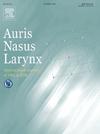A scoping review on postoperative voice therapy for benign vocal fold lesions
IF 1.5
4区 医学
Q2 OTORHINOLARYNGOLOGY
引用次数: 0
Abstract
Objective
This scoping review aims to identify and map the available evidence on postoperative voice therapy specifically for vocal fold nodules, polyps, cysts, Reinke’s edema, papilloma, and granuloma.
Methods
This scoping review followed the Preferred Reporting Items for Systematic reviews and Meta-Analysis extension for Scoping Reviews, 2018. A search of PubMed/MEDLINE, Scopus and Cochrane databases was conducted using Medical Subject Headings when appropriate, free text, and Boolean operators. Two reviewers manually screened each record, and each report was considered based on the predetermined inclusion and exclusion criteria. The same reviewers manually reviewed the collected data from each report. The following data were collected from each paper after piloting a data collection form: first author, year, geographic location, study design, number of participants, vocal fold lesion studied, details of voice therapy, outcome measures, results, and conclusion.
Results
The final number of articles included in the review was 22. The earliest article published included in the review was from 1988. Studies were clustered in certain geographic locations. Case series was the most frequent study design employed, and there was a dearth of experimental studies.
Conclusion
This scoping review reveals the paucity of literature on postoperative voice therapy techniques for benign vocal fold lesions. Standardization in outcome measures, use of multidimensional assessment, and improvement in reporting of interventions are needed. Strategies for postoperative voice therapy to improve voice function after phonosurgery have yet to be clearly established, and this is a clinical issue that needs to be addressed in the future.
良性声带病变术后语音治疗的综述
目的本综述旨在识别和绘制声带术后语音治疗的现有证据,特别是声带结节、息肉、囊肿、Reinke水肿、乳头状瘤和肉芽肿。方法本范围综述遵循2018年系统综述的首选报告项目和范围综述的元分析扩展。检索PubMed/MEDLINE、Scopus和Cochrane数据库,适当时使用医学主题标题、自由文本和布尔运算符。两名审稿人手动筛选每个记录,并根据预先确定的纳入和排除标准考虑每个报告。相同的审阅者手动审阅从每个报告中收集的数据。从每篇论文中收集以下数据:第一作者、年份、地理位置、研究设计、参与者人数、所研究的声带病变、语音治疗的细节、结局测量、结果和结论。结果最终纳入文献22篇。该综述收录的最早一篇文章发表于1988年。研究集中在某些地理位置。病例系列是最常用的研究设计,缺乏实验研究。结论本综述揭示了良性声带病变术后语音治疗技术的文献缺乏。结果衡量标准的标准化、多维评估的使用以及干预措施报告的改进是必要的。术后语音治疗改善声外科术后语音功能的策略尚未明确确立,这是未来临床需要解决的问题。
本文章由计算机程序翻译,如有差异,请以英文原文为准。
求助全文
约1分钟内获得全文
求助全文
来源期刊

Auris Nasus Larynx
医学-耳鼻喉科学
CiteScore
3.40
自引率
5.90%
发文量
169
审稿时长
30 days
期刊介绍:
The international journal Auris Nasus Larynx provides the opportunity for rapid, carefully reviewed publications concerning the fundamental and clinical aspects of otorhinolaryngology and related fields. This includes otology, neurotology, bronchoesophagology, laryngology, rhinology, allergology, head and neck medicine and oncologic surgery, maxillofacial and plastic surgery, audiology, speech science.
Original papers, short communications and original case reports can be submitted. Reviews on recent developments are invited regularly and Letters to the Editor commenting on papers or any aspect of Auris Nasus Larynx are welcomed.
Founded in 1973 and previously published by the Society for Promotion of International Otorhinolaryngology, the journal is now the official English-language journal of the Oto-Rhino-Laryngological Society of Japan, Inc. The aim of its new international Editorial Board is to make Auris Nasus Larynx an international forum for high quality research and clinical sciences.
 求助内容:
求助内容: 应助结果提醒方式:
应助结果提醒方式:


